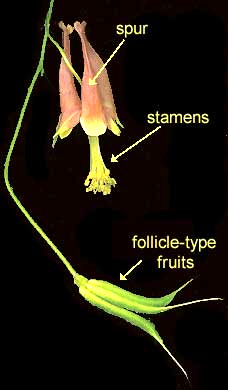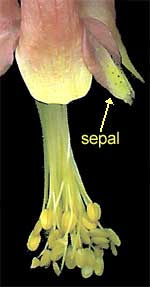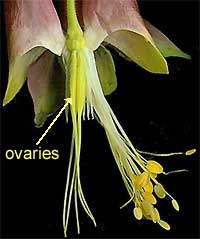
Columbines, members of the Buttercup Family, are members of the genus Aquilegia. Most columbines are red, blue or yellow. Though at first glance their blossoms look like nothing else in the world of flowers, once you analyze what you're seeing, you realize that their basic structure has much in common with our Standard Blossom.
The most striking feature of columbine flowers is the collection of five backwards-projecting spurs, as shown in the image at the right. Each spur is a petal that has developed into something like a tall, slender, hollow hat. At the very top of each spur, inside, is a gland producing sweet nectar. When a pollinator such as a hummingbird comes to stick its beak up into the spurs to sip nectar, in the process it brushes against the stamens, which deposit pollen onto the pollinator. When the pollinator visits the next flower, it leaves some of that pollen on the flower's stigma, thus pollinating the flower.

The Standard Blossom has sepals alternating with petals. The same is true with columbine flowers. However, the Standard Blossom's sepals, as with most flowers, are green and thus very different from the petals. Columbine flowers, in contrast, have sepals colored and textured very much like the petals, though they are shaped very different. At the left you see a pink, yellow-tipped sepal issuing from between two pink, yellow-tipped petal-spurs. That image also shows the stamens very nicely.

Not all the items in the yellow, brushlike affair at the left are stamens. Remembering that the female pistil (the future fruit) is composed of the stigma, style and ovary, we can observe that hidden among the stamens are five slender, stigma-tipped styles arising from five ovaries hidden within the stamen bases. At the right a spur and several stamens have been removed, and the stamen cluster moved to the side, so the ovaries and their slender styles more easily can be seen..
Each pistil will mature into a follicle-type fruit, as described at the top of our Fruit Page.
Often you run into strange columbine flowers in which the petals and/or sepals have been multiplied to make larger, brighter flowers. If you study them long enough you'll see that even they are based on the theme of the Standard Blossom.